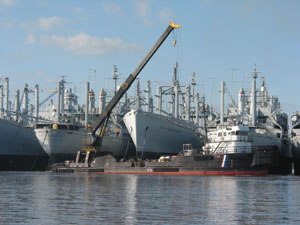NDRF Fleet and Services
Primary Fleet
Section 11 of the Merchant Ship Sales Act of 1946 established the National Defense Reserve Fleet (NDRF), designed provide a reserve of ships for national defense and national emergencies. Today's fleet consists of approximately 100 vessels -- mostly dry cargo ships with a few tankers and military auxiliaries -- some anchored at minor port facilities, but a majority at three major anchor sites: the James River Reserve Fleet at Fort Eustis, Virginia, the Beaumont Reserve Fleet in Beaumont, Texas, and the Suisun Bay Reserve Fleet at Benicia, California. Fleet composition and statuses can vary from month-to-month, but is always divided into 4 classes:
- Ready Reserve Force. Vessels in stand-by status, ready to support DoD surge sealift requirements.
- Retention. Vessels being preserved for federal agency programs, typically to train and deliver supplies. These vessels are effectively in the same condition as when they first entered the fleet, using 1) dehumidification to control the corrosion of metal and growth of mold and mildew, and 2) a cathodic protection system (impressed current of DC power distributed through anodes to the hull) to provide an electric field that suppresses corrosion and preserves exposed hull surfaces. In an example of cooperative inter-agency defense, the Missile Defense Agency sponsors two NDRF ships for missile tracking.
- Non-Retention. Vessels that no longer have a useful application and are pending disposal-related activities.
- Custody. Non-NDRF ships being held for other government agencies on a cost-reimbursable basis.
Ready Reserve Force (RRF)
In 1976, a "Ready Reserve Fleet" component was established within the NDRF to rapidly deploy military equipment. The Ready Reserve Fleet later became the Ready Reserve Force (RRF), an official subset of the NDRF that comprises 46 vessels located strategically at ports throughout the country -- all held in stand-by status. An RRF vessel can be activated and dispatched to any spot on earth within five-to-ten days, designed to support initial military sealift activities, such as transporting various supplies and combat support equipment.
The RRF also supports emergency response during humanitarian crises and through disaster relief, everything from fresh water management and power generation, to housing recovery workers and offering its vessels as command posts.
Click here for details about the RRF
Training
NDRF vessels are also used for training purposes at the United States Merchant Marine Academy and various state maritime schools for cadet training:
- TS Empire State (State University of New York Maritime College)
- TS General Rudder (Texas Maritime Academy)
- TS Golden Bear (California Maritime Academy)
- TS Kennedy (Massachusetts Maritime Academy)
- TS Kings Pointer (United States Merchant Marine Academy)
- TS State of Maine (Maine Maritime Academy)
- TS State of Michigan (Great Lakes Maritime Academy)
Additional NDRF vessels are used for military and homeland security training at NDRF fleet sites.
Ship Disposal
MARAD is the government’s official disposal agent for Federally-owned obsolete, merchant-type vessels, and naval auxiliaries that are equal to or greater than 1,500 gross tons. MARAD disposes of vessels through a variety of environmentally-sound methods, including dismantlement/recycling, sale for recycle and reuse, deep-sinking in conjunction with the U.S. Navy's SINKEX Program, artificial reefing, or donation to qualified non-profit organizations.
Artifact Transfer and Historical Exhibition
MARAD has authority to transfer equipment from its obsolete ships to qualified memorial ships. Over the years, MARAD has provided countless numbers of artifacts and equipment to memorial ships located throughout the U.S.
MARAD is also the custodian of artifacts that document and represent the history of MARAD and its predecessor agencies, going as far back as the 1930s. Its artifact loan program makes MARAD historical artifacts accessible to a wider audience, loaned to organizations that are eligible and qualified under Federal statutes.
Questions?
For questions about the NDRF fleet or its services, contact the Office of Sealift Support.
